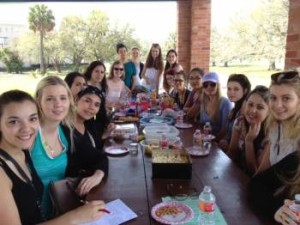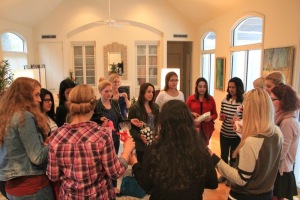Yearly Archives: 2015
Importance of Play
Play. Play. Play. Have you ever seen a child who wanted to stop playing? Play is an important childhood activity and a natural part of a child’s life. Young children do not differentiate between play, work and learning. Children learn about the world around them through play. They enjoy playing and will do it whenever they can.
Do you remember playing as a young child? You may remember riding your bike, sliding down a hill, playing games or playing with your friends. Play is an integral part of children’s lives. Children love to play and they should – it is essential for their overall growth and development!
Play contributes to all areas of a child’s development: physical, cognitive (mental), social and emotional. Playing contributes to the physical development of children by giving them opportunities to explore, discover and master physical skills. Children practice large motor skills by running, jumping, swinging, riding bikes, and kicking balls. They practice fine motor development when drawing with markers or crayons, cutting scissors, or playing with playdough.
Play contributes to children’s cognitive growth and development. By playing children learn concepts, sort and classify information, build their vocabulary, probe for answers, problem-solve, and develop critical thinking skills. Play offers children opportunities to gain more information that sets the foundation for additional learning. For example, when playing with blocks a child may learn that two small blocks equals one large block. Block play can become the foundation for learning math skills and fractions as children get older, and is one example of the endless learning opportunities that exist through play.
Play is vital to a child’s social development. Children learn social skills as they relate to each other while playing. Play helps children learn to get along with others, to share, to take turns, to negotiate, and to compromise. While playing children also discover that not everyone behaves the same way and that some behaviors are not acceptable.
Finally, play contributes to the emotional development of children. Playing provides a way for children to express their feelings and to learn about the feelings of others. Play can help children reduce anxieties, fears and stress. When playing, children develop self-confidence and learn to control their emotional reactions and impulses.
Children at different ages will play differently. Very young children such as infants and toddlers tend to play alone in what is called solitary play. Near age three, children become very interested in pretend or imaginative play. Four-year-olds tend to be more aggressive in their play, while five-year-olds can separate the real world from imaginary play. The older children become, the more they are interested in playing with their friends and peers.
Children should have sufficient time and space for play every day. Children do not necessarily need many playthings – sometimes just their imagination is enough. Accept the playfulness in yourself and have fun with the children. Play is what childhood is all about!
Volunteering at Katrina 10
Au pairs jumped at the opportunity to support their “home for a year” city.
Desiree from South Africa, Nadine, Johanna and Anastasia from Germany joined volunteers at Citywide Day of Service – Katrina 10: Resilient New Orleans.
They spent Saturday, August 29th (the 10th anniversary of Katrina’s strike) working hard at Gentilly Terrace Charter School. They said it was fun and rewarding experience.
Caring for Two or More Children
Everybody likes attention. Children particularly enjoy the attention of adults, and they often want undivided when it is least possible to receive it. The adult needs to have appropriate expectations, set reasonable limits, and problem-solve in creative ways when there is more than one child to care for.
The goal is to find activities that both children can enjoy together. When they are of different ages and abilities, their attention span and understanding of the game or project may be different as well, but still the tasks can be adjusted to suit different children. For example, if two children are involved in cooking, one may be able to carefully measure ingredients, and the other child can be in charge of pouring the ingredients into the bowl. If an older child is carefully working on a coloring project, give a younger child his own sheet of paper and crayons, making it clear that everyone is working on their own. Keep the tasks age-appropriate, and save the ‘grown up’ activities involving small pieces or sustained concentration for the younger child’s nap time.
It is important to remember that children of different ages will play with the same toys in different ways, depending on their age and ability. The adult may need to work to keep the younger child engaged with the activity longer, so as not to interfere with the older child’s efforts. For example, they could both play with blocks, but it may take adult intervention to keep a younger child from disturbing what the older child has built. The older child may be interested in creating an elaborate building or a city with cars, people or animals. Perhaps the younger child can play with it after it is built.
When playing a game with two children of different abilities, it may be necessary to change the rules to accommodate everybody. Try enlisting the understanding of the older child; remind her that she wasn’t always able to do all the things she does now. An older child can take pleasure in helping a younger brother or sister learn new skills. Have the children take turns playing “follow the leader” or “hide and seek.” Games of imagination work well, with the children taking different roles, or a scavenger hunt, with the adult giving necessary assistance to the younger child.
An older child may not always like this attention-sharing. You can give him the choice of doing the activity with you and the younger child in the way you have described, or to play by himself. Try planning ahead for the younger child’s nap time and arrange to do a special activity with the older child then, but don’t be disappointed if the older child turns you down. Children sometimes only want attention when they can’t have it.
The adult must be sure that each child does get appropriate attention, and that one child is not always being sacrificed for the other. It is easy to give a baby more attention, but babies can learn at an early age to watch and participate with others too. It may even be possible to hold a younger child on your lap while you do more grown up things with the older child. Babies can also be left to play by themselves in a playpen or a crib for short periods of time to enable the older child to have some one-on-one attention.
Remember that whatever the activity, you must be able to see both (or all) the children to be sure they are safe.
Thanks to Etta Rosen for this article.















